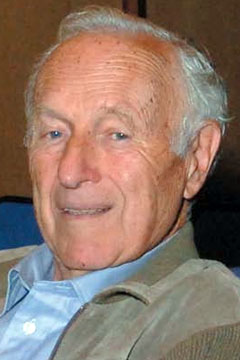Demystifying Medicine: Commentary
Need for a bridge and how to build it
— By Win Arias
Dr. Irwin Arias is a senior scientist at the Eunice Kennedy Shriver National Institute of Child Health and Human Development and director of the Demystifying Medicine course at the National Institutes of Health (NIH).

“Much is known but unfortunately in different heads.”
— German pathologist, Werner Kollath, 1949
The public demands that its large investment in science will eventually result in improvements in human health. For the past half-century, advances in biology and technology have occurred logarithmically; however, their application to understanding and treating human disease has proceeded only arithmetically, creating an increasing gap. Reasons for this gap include a shortage of physician-scientists, who bring a unique perspective to their research because they have cared for patients and have a knowledge of disease, and difficulties in teaching advanced biology to physicians and pathobiology to basic scientists.
Programs that attempt to address this problem include translational medicine, bench-to-bedside research, the NIH Roadmap (which addresses roadblocks to research), the Howard Hughes Medical Institute’s (HHMI) Med into Grad initiative (which aims to help future PhD biomedical researchers develop an understanding of medically relevant principles) and others. All are based on the concept that communication between basic and clinical disciplines is critical.
Many public and private initiatives seek to increase the number of physician-scientists and MD/PhD students. But considerably less attention has been paid to the teaching aspect as a way to facilitate interactions between clinicians and physician-scientists. All programs to bridge the gap assume that if research funding is disease-related, communication between scientists and clinicians will automatically occur. Such communication is unlikely to happen unless we teach new research possibilities to clinicians and pathobiology and clinical problems to basic scientists.
Less well appreciated is that the decline in the number of physician-scientists has created excellent academic positions for PhDs in clinical departments. In 1993, 40% of PhDs in academic centres were in clinical departments, according to the Association of American Medical Colleges. In 2008, the figure exceeded 80% (several less complete studies cite 40%). Many of those positions are tenure track. In fact, PhDs currently have greater opportunities in clinical departments than in traditional basic science departments.
For reasons that are not obvious, this changing paradigm has attracted little attention. For example, in recent national conferences on careers that linked basic science and medicine, there was no mention of opportunities for PhDs in clinical departments. And because medical school graduate program directors tend to have little experience in medicine and pathobiology, their PhD students don’t get many opportunities to learn about clinical medicine. The separation between pure science and human health grows even wider. In my view, this critical gap contributes to the difficulty of linking science and medicine.
Remarkable new technologies, including genome-based personalized medicine, hold great promise for better understanding disease. It therefore becomes all the more important for clinicians and physician-scientists to collaborate. But first, basic scientists need to understand the clinical aspects of disease in order for such collaborations to be effective.
Considerable data support the timeliness for teaching pathobiology to PhD students and fellows. Surveys reveal that most students who choose medical-school-based graduate programs, over university-based, ones seek research careers that will influence human health. Successful pathobiology programs ranging from PhDs in translational medicine to single courses have increased in number. For example, in 2006 HHMI’s Med into Grad program awarded $10 million to 13 institutions. The program was so successful that HHMI plans to award up to $25 million to 25 institutions in 2010.
In 2000, we began a novel course at NIH entitled Demystifying Medicine, to bridge the gap between advances in biology and their application to major human diseases. To accommodate the many PhDs at NIH, we instituted a format resembling old-fashioned Medical Grand Rounds, in which patients were presented. From January through May, we offer weekly two-hour sessions featuring major diseases, where a live patient explains what it’s like to have the disease, a physician-investigator discusses clinical advances and challenges and a basic scientist presents the latest research findings. Demystifying Medicine has been well received by scientists at all levels. About 800 individuals register each year, many attending in person and countless others watching sessions via livestreams or archived videos. More than 24 institutions use the sessions for teaching students and fellows. Involving patients puts a human face on a disease and scientists, as well as physicians, are motivated to learn more.
Substantial evidence indicates that these educational efforts influence the careers of PhD scientists. Outcomes data from three different programs in the biological sciences that have introduced targeted medically relevant material into their curriculum — Harvard-Massachusetts Institute of Technology Division of Health Sciences and Technology Program (Boston, Mass.), Washington University (St. Louis, Mo.), Tufts (Boston, Mass.) — reveal that five years after completion of postdoctoral work, approximately one third of graduates had acquired academic positions in clinical departments, compared with fewer than 10% who completed traditional PhD programs (Nature Med 8: 433-6, May 8, 2002).
Teaching pathobiology to PhDs is timely, challenging, supported by outcomes data, and, for some, preparatory for academic positions in clinical departments. The goal is not to become physicians but to be able to communicate and share ideas with clinical investigators. As Tom Cech, former President of HHMI, stated: “It is self-evident that scientists working on problems which may have clinical relevance should know about the disease and how it affects people.”
